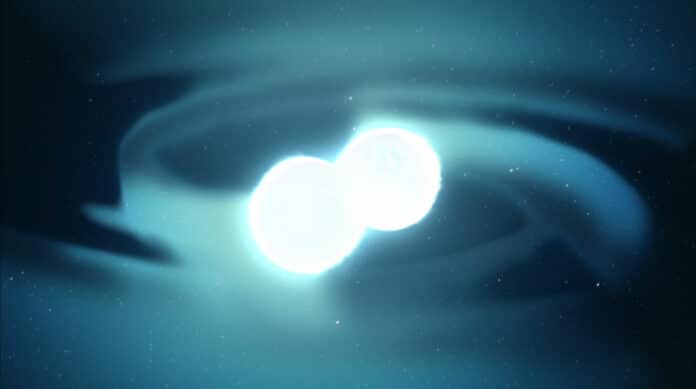Short gamma-ray bursts (GRBs) are associated with binary neutron star mergers, multimessenger astronomical events observed in gravitational waves, and the multiband electromagnetic spectrum. Depending on the masses of the stars in the binary and on details of their largely unknown equation of state, a dynamically evolving and short-lived neutron star may be formed after the merger.
Astronomers who have been examining old data on explosive explosions known as short gamma-ray bursts (GRBs) have found light patterns that suggest a superheavy neutron star existed briefly before collapsing into a black hole. The collision of two neutron stars probably created this fleeting, massive object.
Cecilia Chirenti, a researcher at the University of Maryland, College Park (UMCP) and NASA’s Goddard Space Flight Center in Greenbelt, Maryland, said, “We looked for these signals in 700 short GRBs detected with NASA’s Neil Gehrels Swift Observatory, Fermi Gamma-ray Space Telescope, and the Compton Gamma Ray Observatory. We found these gamma-ray patterns in two bursts observed by Compton in the early 1990s.”
The Compton measurements and computer simulations showed that the mass of mega neutron stars was 20% greater than that of the most massive, accurately measured neutron star, J0740+6620, which is almost 2.1 times the mass of the Sun. Additionally, compared to regular neutron stars, superheavy neutron stars are almost two times large or around twice the length of Manhattan Island.
The mega neutron stars rotate roughly 78,000 times per minute, nearly twice as fast as J1748-2446ad, the fastest pulsar yet observed. This quick spin prevents the items from collapsing further for only a few tenths of a second before they proceed to form a black hole faster than the speed of light.
Cole Miller, a professor of astronomy at UMCP and a co-author of the paper, said, “We know that short GRBs form when orbiting neutron stars crash together, and we know they eventually collapse into a black hole, but the precise sequence of events is not well understood. At some point, the nascent black hole erupts with a jet of fast-moving particles that emits an intense flash of gamma rays, the highest-energy form of light, and we want to learn more about how that develops.”
Computer simulations of these mergers show that gravitational waves exhibit a sudden frequency jump exceeding 1,000 hertz as the neutron stars coalesce. These signals are too fast and faint for existing gravitational wave observatories to detect. But Chirenti and her team reasoned that similar signals could appear in the gamma-ray emission from short GRBs. These signals are known as quasiperiodic oscillations or QPOs for short.
QPOs can be composed of several close frequencies that vary or dissipate over time. The gamma-ray and gravitational wave QPOs originate in the maelstrom of swirling matter as the two neutron stars coalesce.
While no gamma-ray QPOs materialized in the Swift and Fermi bursts, two short GRBs recorded by Compton’s Burst And Transient Source Experiment (BATSE) on July 11, 1991, and Nov. 1, 1993, fit the bill.
The advantage in locating these elusive patterns—the distinctive flickering that indicated the presence of massive neutron stars—belonged to the BATSE instrument’s broader field of view. The team estimates that there is a less than 1 in 3 million chance that all of these signals will appear by chance alone.
Chryssa Kouveliotou, chair of the physics department at George Washington University in Washington, said, “These results are significant as they set the stage for future measurements of hypermassive neutron stars by gravitational wave observatories.”
Journal Reference:
- Chirenti, C., Dichiara, S., Lien, A. et al. Kilohertz quasiperiodic oscillations in short gamma-ray bursts. Nature (2023). DOI: 10.1038/s41586-022-05497-0
